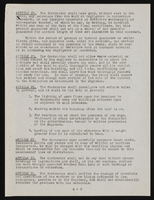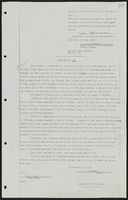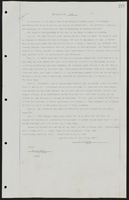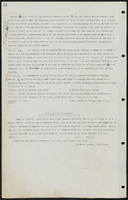Search the Special Collections and Archives Portal
Search Results
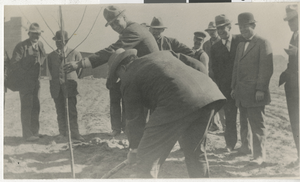
Photograph of people planting first tree in the courthouse park, Las Vegas in March 1911
Date
1911-03
Archival Collection
Description
Black and white photo taken by C. P. Squires on the occasion of planting the first tree in the courthouse park, Las Vegas, Nevada. Date, March 1911, as near as can be fixed. The building shown at left is the first Clark County Court House (now used for Las Vegas City Library) which had been constructed by popular subscription by Las Vegas Business men as promised by them during the county division campaign in 1908-1909. This building provided sufficient quarters for the county offices for five years, following which, the present court house was built. Persons shown, so far as their identity can be remembered are: holding the tree- Ed W. Clark and using the shovel is Judge E. J. L Taber. Others, left to right: Charlie Ronnow, Judge W. R. Thomas, unidentified, unidentified, Bob Dillon, Frank A. Stevens, Harley A. Harmon, and Dr. Roy W. Martin.
Image
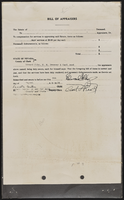
Stewart family real estate documents
Date
1950 to 1959
Archival Collection
Description
Stewart family real estate documents
Text
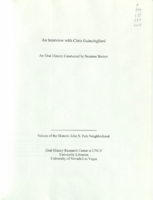
Transcript of interview with Chris Guinchigliani by Suzanne Becker, July 20, 2007
Date
2007-07-20
Archival Collection
Description
Three decades prior to this interview, Chris Guinchigliani moved to Las Vegas and began teaching at the Clark County School District. Seeing Las Vegas as a place of personal opportunity, she involved herself first in the teachers union; eventually serving as president of the Nevada State Education Association from 1987 through 1991. She shares some of her political experiences being elected to the Nevada State Assembly for 16 years and then became a Clark County Commissioner. Chris and her husband Gary Gray (above left) are longtime residents of the John S. Park Neighborhood and Chris was among those who originated the idea to getting a historical designation for the community. She highlights the process and obstacles within the community as people developed an understanding about what preservation really meant. She touches upon a broad range of topics that living in the neighborhood: Manhattanization, increased traffic, crime, lack of amenities such as a grocery store, the
Text

Photograph of the interior of the Shubert Theatre, Cincinnati (Ohio), 1970
Date
1970
Archival Collection
Description
The Shubert Theatre stage as seen from the upper house left side of the balcony seats. Two sections of box seats are visible. The intricate wall designs are visible above the box seats and above the exit for the balcony rows. The 3,000 seat Shubert Theater was built inside what was originally the city’s original YMCA (which opened in 1848). The theater opened in 1921 as a venue for legitimate theatrical performances. The Shubert Theater switched to a combined use venue for movies and stage shows in 1935. The theater was closed in 1953 and reopened as Rev. Earl Ivies' Revival Temple. Just two years later, however, the Shubert Theater was renovated and once again returned to legitimate theater. In 1976, the Shubert Theater was demolished to make way for a parking lot. Today, there is an office building on the site. Site Name: Shubert Theater (Cincinnati, Ohio) Street Address: 90 East 7th Street
Image
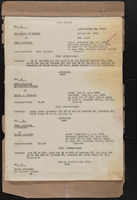
Stewart family real estate documents
Date
1920 to 1929
Archival Collection
Description
Stewart family real estate documents
Text
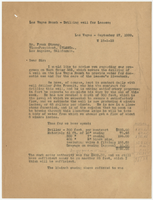
Letter from Walter R. Bracken (Las Vegas) to Frank Strong (Los Angeles), September 27, 1939
Date
1939-09-27
Archival Collection
Description
Letter stating status of the work and cost of well drilling on the Las Vegas Ranch.
Text
Pagination
Refine my results
Content Type
Creator or Contributor
Subject
Archival Collection
Digital Project
Resource Type
Year
Material Type
Place
Language
Records Classification

